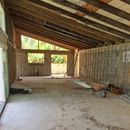Insulating a 3 inch vaulted ceiling
My name is Gary Bushong, I am remodeling a older home in Fort Lauderdale Florida, The great room in the picture has been gutted and the rafters exposed. We are remodeling it exposing 5 ” of the 8″ existing rafter when complete (key west style ceiling). Doing this type of exposed ceiling is only allowing us only 3″ of space between the tongue and groove roof base and the new tongue and groove ceiling. I am looking for suggestions on what insulation product would be best suited for a minimum R value of 19 in this 3″ space ?
GBA Detail Library
A collection of one thousand construction details organized by climate and house part










Replies
Gary,
If you really want an insulation with an R-value of R-6.3 per inch, you are restricted to either polyisocyanurate or closed-cell spray foam.
That said, you are choosing an insulation method that has many drawbacks. If you plan to cut rigid foam into narrow rectangles and to insert the rectangles between your rafters, you will not be addressing the thermal bridging through the rafters -- and the performance of your roof will suffer.
It would be far better to install the 3 inches of polyiso as a continuous layer of insulation. The easiest way to do this is to install the rigid foam above your existing roof sheathing. Of course, this approach requires you to install new roofing. But it is by far the best way to proceed.
For more information, see How to Install Rigid Foam On Top of Roof Sheathing.
To get R19 in 3" of space the only commonly found option is closed cell spray polyurethane foam, which is one of the least-green insulation materials out there. But there are degrees of "bad". Closed cell foam blown with HFC245fa does many times the environmental damage that HFO1234ze does. Unfortunately the HFC blown stuff is the standard, but there are a few vendors with HFO blown foam products now, eg:
Demilec HFO High Lift
LaPolla Foam-Lok 2000-4G
see also:
https://www.greenbuildingadvisor.com/blogs/dept/green-building-blog/friendlier-foam-insulation-way-eventually